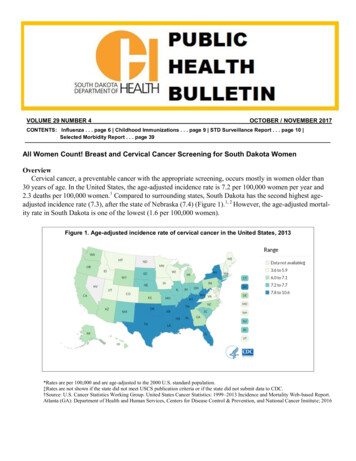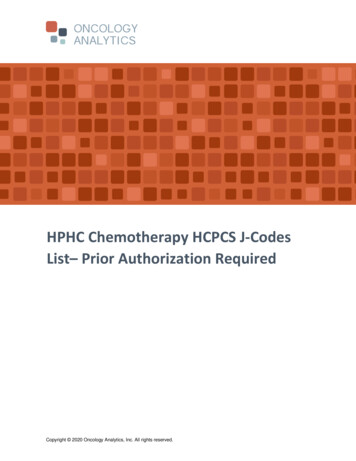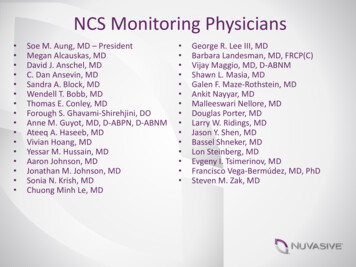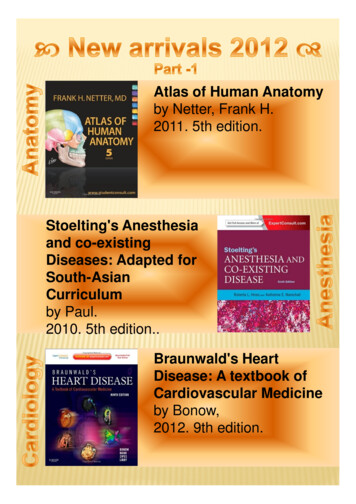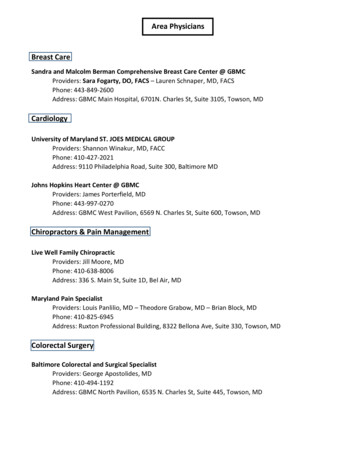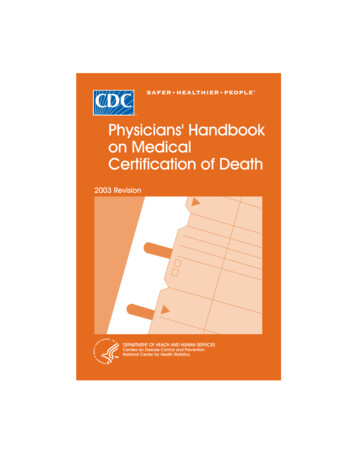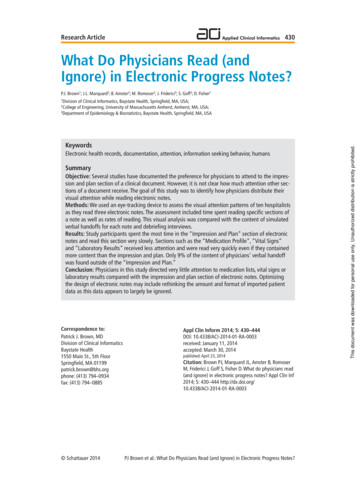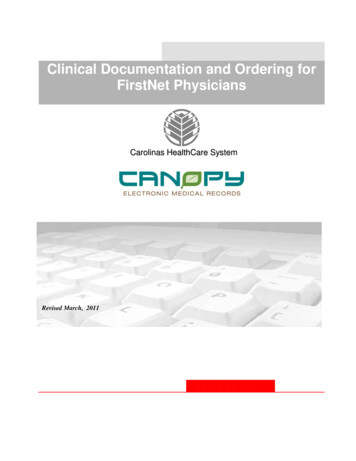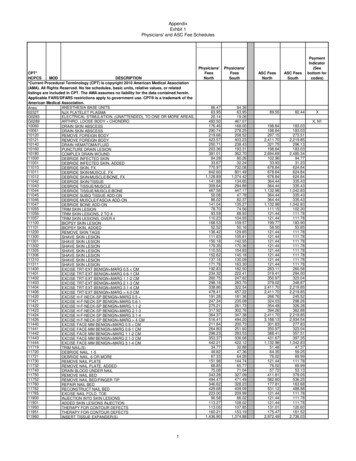
Transcription
Physicians’Cancer ChemotherapyDrug Manual2015
Other Jones & Bartlett Learning Oncology TitlesBreast Cancer Treatment by Focused Microwave Thermotherapy, FennCancer in Children and Adolescents, Carroll/FinlayContemporary Issues in Breast Cancer: A Nursing Perspective, 2e, Hassey DowDx/Rx: Brain Tumors, QuantDx/Rx: Breast Cancer, 2e, LakeDx/Rx: Cervical Cancer, 2e, Robison/DizonDx/Rx: Colorectal Cancer, Holen/ChungDx/Rx: Genitourinary Oncology: Cancer of the Kidney, Bladder, and Testis, 2e, GalskyDx/Rx: Gynecologic Cancer, Dizon/CamposDx/Rx: Head and Neck Cancer, Hu et al.Dx/Rx: Liver Cancer, Abou-Alfa/AngDx/Rx: Lung Cancer, 2e, AzzoliDx/Rx: Leukemia, 2e, BurkeDx/Rx: Lymphoma, PerskyDx/Rx: Melanoma, CarvajalDx/Rx: Palliative Cancer Care, Malhotra/MorylDx/Rx: Pancreatic Cancer, Lowery/O’ReillyDx/Rx: Prostate Cancer, 2e, KampelDx/Rx: Upper Gastrointestinal Malignancies: Cancers of the Stomach and Esophagus, ShahGenomic and Molecular Neuro-Oncology, Zhang/FullerGlioblastoma Multiforme, Markert et al.Gynecologic Tumor Board: Clinical Cases in Diagnosis and Management of Cancer ofthe Female Reproductive System, Dizon/Abu-RustumHandbook of Breast Cancer Risk-Assessment, Vogel/BeversHandbook of Cancer Emergencies, MarinellaHandbook of Cancer Risk Assessment and Prevention, Colditz/SteinHandbook of Radiation Oncology: Basic Principles and Clinical Protocols, Haffty/WilsonHow Cancer Works, SompayracManagement of Nausea and Vomiting in Cancer and Cancer Treatment, HeskethMedical and Psychosocial Care of the Care Survivor, MillerMolecular Oncology of Breast Cancer, Ross/HortobagyiMolecular Oncology of Prostate Cancer, Ross/FosterPancreatic Cancer, Von Hoff/Evans/HrubanPediatric Stem Cell Transplantation, MehtaPocket Guide to Chemotherapy Protocols, 7e, ChuTarascon Pocket Oncologica, MarinellaThe Cancer Book, CooperThe Hospital for Sick Children Handbook of Supportive Care in Pediatric Oncology,AblaThe Johns Hopkins Breast Cancer Handbook for Health Care Professionals, Shockney/TsangarisFor a complete list of our oncology titles, see www.jblearning.com/medicine/oncology.
Physicians’CancerChemotherapyDrug Manual2015Edward Chu, MDProfessor of Medicine and Pharmacology & Chemical BiologyChief, Division of Hematology-OncologyDeputy DirectorUniversity of Pittsburgh Cancer InstituteUniversity of Pittsburgh School of MedicinePittsburgh, PAVincent T. DeVita, Jr., MDAmy and Joseph Perella Professor of MedicineProfessor of Epidemiology and Public HealthYale University School of MedicineNew Haven, CT
World HeadquartersJones & Bartlett Learning5 Wall StreetBurlington, MA .comJones & Bartlett Learning books and products are available through most bookstores andonline booksellers. To contact Jones & Bartlett Learning directly, call 800-832-0034, fax978-443-8000, or visit our website, www.jblearning.com.Substantial discounts on bulk quantities of Jones & Bartlett Learning publications are available to corporations, professional associations, and other qualified organizations. For detailsand specific discount information, contact the special sales department at Jones & BartlettLearning via the above contact information or send an email to specialsales@jblearning.com.Copyright 2015 by Jones & Bartlett Learning, LLC, an Ascend Learning CompanyISBN: 978-1-284-07521-2All rights reserved. No part of the material protected by this copyright notice may be reproducedor utilized in any form, electronic or mechanical, including photocopying, recording, or by anyinformation storage and retrieval system, without written permission from the copyright owner.The content, statements, views, and opinions herein are the sole expression of the respectiveauthors and not that of Jones & Bartlett Learning, LLC. Reference herein to any specific commercial product, process, or service by trade name, trademark, manufacturer, or otherwise does notconstitute or imply its endorsement or recommendation by Jones & Bartlett Learning, LLC andsuch reference shall not be used for advertising or product endorsement purposes. All trademarksdisplayed are the trademarks of the parties noted herein. Physicians’ Cancer Chemotherapy DrugManual 2015 is an independent publication and has not been authorized, sponsored, or otherwiseapproved by the owners of the trademarks or service marks referenced in this product.There may be images in this book that feature models; these models do not necessarilyendorse, represent, or participate in the activities represented in the images. Any screenshots in this product are for educational and instructive purposes only. Any individuals andscenarios featured in the case studies throughout this product may be real or fictitious, butare used for instructional purposes only.The authors, editor, and publisher have made every effort to provide accurate information.However, they are not responsible for errors, omissions, or for any outcomes related to the useof the contents of this book and take no responsibility for the use of the products and proceduresdescribed. Treatments and side effects described in this book may not be applicable to all people;likewise, some people may require a dose or experience a side effect that is not described herein.Drugs and medical devices are discussed that may have limited availability controlled by theFood and Drug Administration (FDA) for use only in a research study or clinical trial. Research,clinical practice, and government regulations often change the accepted standard in this field.When consideration is being given to use of any drug in the clinical setting, the health careprovider or reader is responsible for determining FDA status of the drug, reading the packageinsert, and reviewing prescribing information for the most up-to-date recommendations ondose, precautions, and contraindications, and determining the appropriate usage for the product. This is especially important in the case of drugs that are new or seldom used.Production CreditsExecutive Editor: Nancy Anastasi DuffySenior Production Editor: Dan StoneDirector of Special Markets: Eileen WardV.P., Design and Production: Anne SpencerRights and Photo Research Coordinator: Ashley Dos SantosManufacturing and Inventory Control Supervisor: Amy BacusComposition: Cenveo Publisher ServicesCover Image: xrender/ShutterstockCover Design: Kristin E. ParkerPrinting and Binding: Edward Brothers MalloyCover Printing: Edward Brothers Malloy6048Printed in the United States of America10 9 8 7 6 5 4 3 2 118 17 16 15 14
ContentsEditors and Contributing AuthorsviPrefaceviiAcknowledgmentsviiiChapter 1Chapter 2Principles of Cancer Chemotherapy1Introduction1The Role of Chemotherapy in the Treatment of Cancer2Principles of Combination Chemotherapy3Chemotherapeutic and Biologic Drugs5Chapter 3 Guidelines for Chemotherapy and DosingModifications467Chapter 4 Common Chemotherapy Regimens inClinical Practice487Chapter 5 Antiemetic Agents for the Treatment ofChemotherapy-Induced Nausea and Vomiting625Index665v
EditorsEdward Chu, MDProfessor of Medicine and Pharmacology & Chemical BiologyChief, Division of Hematology-OncologyDeputy DirectorUniversity of Pittsburgh Cancer InstituteUniversity of Pittsburgh School of MedicinePittsburgh, PAVincent T. DeVita, Jr., MDAmy and Joseph Perella Professor of MedicineProfessor of Epidemiology and Public HealthYale University School of MedicineNew Haven, CTContributing AuthorsM. Sitki Copur, MDRyan Ramaekers, MDAdjunct Professor of MedicineUniversity of NebraskaMedical Director, Saint FrancisCancer CenterGrand Island, NEAdjunct Assistant Professor of MedicineUniversity of NebraskaSaint Francis Cancer CenterGrand Island, NELaurie J. Harrold, MDClinical Nurse SpecialistHematology-Oncology AssociatesMeriden, CTDawn E. Tiedemann, AOCN, APRNMedical OncologistPittsburgh, PAvi
PrefaceThe development of effective drugs for the treatment of cancer represents asignificant achievement beginning with the discovery of the antimetabolitesand alkylating agents in the 1940’s and 1950’s. The success of that effort can beattributed in large measure to the close collaboration and interaction betweenbasic scientists, synthetic organic chemists, pharmacologists, and clinicians.This tradition continues to flourish, especially as we now enter the world of pharmacogenomics, genomics, and proteomics, and the rapid identification of newmolecular targets for drug design and development.In this, our 15th edition, we have condensed and summarized a wealth of information on chemotherapeutic and biologic agents in current clinical practice intoa reference guide that presents essential information in a practical and readableformat. The primary indications, drug doses and schedules, toxicities, and specialconsiderations for each agent have been expanded and revised to take into accountnew information that has been gathered over the past year. We have also includedsix new agents that have all been approved by the FDA within the past year.This drug manual is divided into five chapters. Chapter 1 gives a brief overviewof the key principles of cancer chemotherapy and reviews the clinical settingswhere chemotherapy is used. Chapter 2 reviews individual chemotherapeuticand biologic agents that are in current clinical use; these agents are presentedin alphabetical order according to their generic name. In this chapter, specificdetails are provided regarding drug classification and category, key mechanismsof action and resistance, critical aspects of clinical pharmacology and pharmacokinetics, clinical indications, special precautions and considerations, andtoxicity. Chapter 3 includes recommendations for dose modifications that arerequired in the setting of myelosuppression and/or liver and renal dysfunction.Relevant information is also provided highlighting the teratogenic potential ofvarious agents. Chapter 4 presents a review of the combination drug regimensand selected single-agent regimens for solid tumors and hematologic malignancies that are used commonly in daily clinical practice. This section is organizedalphabetically by specific cancer type. Finally, Chapter 5 reviews commonly usedantimetic agents and individual agents used to treat chemotherapy-inducednausea and vomiting, which is a significant toxicity observed with many of theanticancer agents in current practice.Our hope remains for this book to continue to serve as both an in-depthreference and an immediate source of practical information that can be used byphysicians and other healthcare professionals actively involved in the daily careof cancer patients. This drug manual continues to be a work in progress, and ourgoal is to continue to update it on an annual basis and to incorporate new drugsand treatment strategies that reflect the ongoing advances in the field of cancerdrug development.Edward Chu, MDVincent T. DeVita, Jr., MDvii
AcknowledgmentsThis book represents the efforts of many dedicated people. It reflects my ownpersonal and professional roots in the field of cancer pharmacology and cancerdrug development. It also reaffirms the teaching and support of my colleaguesand mentors at Brown University, the National Cancer Institute (NCI), and theYale Cancer Center. In particular, Bruce Chabner, Paul Calabresi, Robert Parks,Joseph Bertino, and Vince DeVita have had a major influence on my development as a cancer pharmacologist and medical oncologist. While at the NCI, Iwas fortunate to have been trained under the careful tutelage of Carmen Allegra,Bob Wittes, and Bruce Chabner. At Yale, I was privileged to work with a group ofextraordinarily talented individuals including Yung-chi Cheng, William Prusoff,Alan Sartorelli, and Vince DeVita, all of whom have graciously shared their scientific insights, wisdom, support, and friendship. I would also like to take thisopportunity to thank my co-author, colleague, mentor, and friend, Vince DeVita,who recruited me to the Yale Cancer Center and who has been so tremendouslysupportive of my professional and personal career. Special thanks go to my colleagues at Jones & Bartlett Learning for giving me the opportunity to develop thisbook and for their continued encouragement, support, and patience throughoutthis entire process. I wish to thank my wife, Laurie Harrold, for her love andpatience, for her insights as a practicing medical oncologist, and for her help inwriting and reviewing various sections of this book. I would also like to thank myparents, Ming and Shih-Hsi Chu, for their constant love, support, and encouragement, and for instilling in me the desire, joy, and commitment to become amedical oncologist and cancer pharmacologist. Finally, this book is dedicated tomy faithful dogs, Mika and Lexi, and to my two beautiful children, Ashley andJoshua, who have brought me great joy and pride and who have shown me thetrue meaning of unconditional loyalty and love.Edward Chu, MDviii
1Principles of CancerChemotherapyVincent T. DeVita, Jr. and Edward ChuIntroductionThe development of chemotherapy in the 1950’s and 1960’s resulted in curative therapeutic strategies for patients with hematologic malignancies andseveral types of advanced solid tumors. These advances confirmed the principle that chemotherapy could indeed cure cancer and provided the rationalefor integrating chemotherapy into combined-modality programs with surgery and radiation therapy in early stages of disease to provide clinical benefit. Since its early days, the principal obstacles to the clinical efficacy ofchemotherapy have been toxicity to the normal tissues of the body and thedevelopment of cellular drug resistance. The development and application ofmolecular techniques to analyze gene expression of normal and malignantcells at the level of DNA, RNA, and/or protein has greatly facilitated theidentification of some of the critical mechanisms through which chemotherapy exerts its antitumor effects and activates the program of cell
Handbook of Breast Cancer Risk-Assessment, Vogel/Bevers Handbook of Cancer Emergencies, Marinella Handbook of Cancer Risk Assessment and Prevention, Colditz/Stein Handbook of Radiation Oncology: Basic Principles and Clinical Protocols, Haffty/ Wilson How Cancer Works, Sompayrac Management of Nausea and Vomiting in Cancer and Cancer Treatment, Hesketh Medical and
